PinotFile: 8.44 October 4, 2011
|
Joe Rochioli Jr. - No Ordinary JoeJoe Rochioli Jr. is the patriarch of Russian River Valley Pinot Noir. A humble, but proud man, he possesses an indefatigable devotion to his vineyard. His personal history is marked by numerous notable achievements that inseparably link him to the history of winegrowing in the Russian River Valley. Joe’s family history begins with his grandfather who was born in Northern Italy and at a very young age was left on a doorstep in town. The family that initially cared for him was extremely poor and eventually sent him to an orphanage. Since he had no name, he was given the name “Rochioli” (“Ro-kee-o-lee”) at the orphanage, a word in Italian that had no meaning. Joe’s father, Joe Rochioli, Sr., was also born in Northern Italy. He later immigrated to the United States in 1912, following in the footsteps of many other Italian-American immigrants who were to become notable families in the Sonoma County winescape including Martini, Martinelli, Pedroncelli, Sebastiani, and Seghesio. Joe Rochioli, Jr., was born in Sebastopol in 1934. In 1938 his family moved to nearby land known as Wohler Ranch adjacent the Russian River in Healdsburg that Joe, Sr., leased from the Walters family. Solomon Walters and his wife had come from North Carolina in a covered wagon and in 1885 they bought about 500 acres including a portion on Westside Road that Joe Rochioli, Sr., farmed. The large farm grew hops, fruit, grapes, prunes and vegetables. After settling on the ranch, Joe, Sr., began buying portions of the ranch until he would eventually own 162 acres. Joe, Jr.’s family lived completely from the land and was very poor. They only spoke Italian at home and when Joe, Jr., entered school at the age of six, he understood very little English. At a one-room schoolhouse two miles up the road, Joe, Jr., was ridiculed for has lack of English and his home made lunches. Life was hard, with Joe, Jr., working daily on his father’s farm in his formative years. By age 12, he was doing a man’s work, lifting 60 pound sacks of hops in the hop kiln and worked daily after school until he began playing sports in high school. When he entered Healdsburg High School, he was 6-foot tall, weighed 160 pounds, and wore size 12 shoes. His mother thought there was something wrong with him because he grew so fast. As a freshman, he was caught fooling around by the football coach. He promptly ordered him to do 100 pushups which he easily accomplished without breaking a sweat. The coach was so impressed he asked him to come out for the football team. Joe, Jr., had never seen the game played, but quickly became a star linebacker. He also started playing baseball his freshman year and earned all-league honors in both football and baseball. He was one of the first athletes to be elected into the Hall of Fame at Healdsburg High School. Joe, Jr., helped organize the first Future Farmer Fair in Healdsburg which is still held today and was the President for both the Future Farmers of America and the Block H (athletic) Club. He won just about every award offered in high school and with a scholarship in hand, headed to Cal Poly San Luis Obispo where he played baseball all four years. He majored in Animal Science, but took all the agricultural electives he could. In 1957, he was drafted into the army where he participated in research on radiated foods and vitamin deficiencies among K rations. After leaving the service in 1959, Joe, Jr., was offered a high-paying civilian job, but his father expected him to return home and work on the ranch. Instead of the $10,500 annual pay he would have received for the civilian job, his father gave him $1.00 an hour or barely $3,000 a year. He supplemented that income playing semi pro baseball for ten years with the Healdsburg Prune Packers. Joe, Sr., was primarily in the hops business but the property he farmed also had 50 acres of grapevines dating to the 1890s, consisting mainly of a field blend typical for the time composed of Grand Noir, Alicante Bouschet, Zinfandel, Petite Sirah, Sauvignon Vert, and Black Malavasia. Grapes provided little income in the 1940s, returning $50 to $70 a ton. Yields on the family vineyard were typically one and half to two tons per acre. When the hops business declined in 1953, hops were taken out and Blue Lake string beans planted. The hop trellises were simply lowered to accommodate the new crop. The crop broke all state records for production and Joe, Sr., became one of the largest string bean growers in California. The old grapevines were eventually ripped out in 1957 and French Colombard and Cabernet Sauvignon planted the following year. In the mid 1960s, string beans were interplanted in the vineyard. The trellis was dug out and beans were planted on stakes with two rows of beans between each row of grape vines. By the time Joe, Jr., returned from college in 1959, Joe, Sr., had acquired the entire property he had been leasing. Joe, Jr., took over the grape growing but Joe, Sr., was still clearly the boss. Joe, Jr., wanted to plant additional vinifera varieties as he felt the future of grape growing in the Russian River Valley lay in varietal wines, but his father was reluctant because wine grapes produced small crops and did not attract significant money at the time. Joe, Jr., finally talked his father into planting Sauvignon Blanc in 1959. Joe, Jr., traveled to University of California Davis where Sauvignon Blanc was planted to multiple clones. He walked the rows and tasted the grapes, finally deciding on budwood from the one row he thought tasted best. The 10 acres of Sauvignon Blanc vines he planted were so vigorous he had to trellis them on a double-Geneva configuration (see photo below). For several years, the Sauvignon Blanc grapes were sold to Chateau St. Jean and other wineries and went into white blends. It wasn’t until 1969 that Windsor Winery bottled the Sauvignon Blanc as a distinct varietal. The vines are still producing today and Rochioli Sauvignon Blancs have won more awards than any other wine Rochioli produces. The Sauvignon Blanc vines at University of California Davis were subsequently pulled out and Joe, Jr., was never able to obtain more of the same budwood. The type of Sauvignon Blanc clone planted at Rochioli Vineyard will forever remain a mystery.
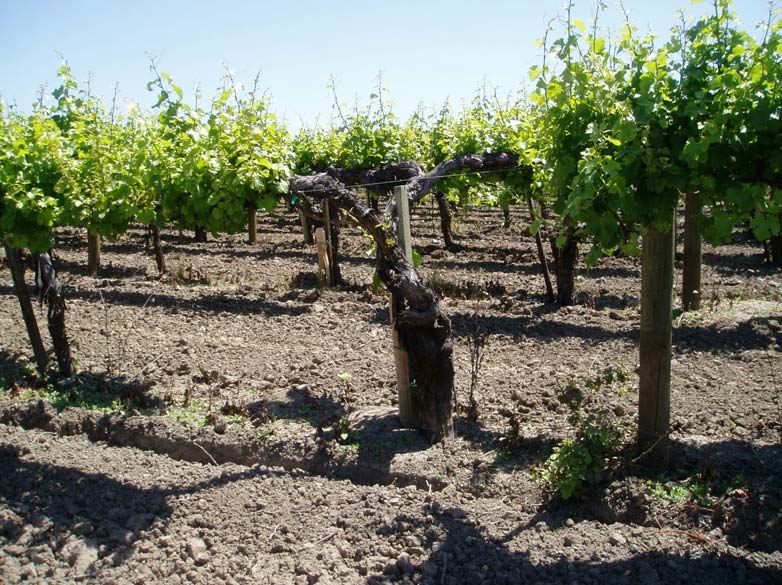 Labor had become difficult to find in the early 1960s and by 1963 all the string beans had been pulled out on the ranch. Joe, Jr., begged his father to try Pinot Noir. He was aware of the quality of French red Burgundy and had a hunch that the grape would do well on the Rochioli ranch. He knew that the land at the ranch had seven feet of fertile soil over gravel and a suitable climate. Although University of California Davis had developed a Pinot Noir clone (Gamay Beaujolais) that was very vigorous and would be more profitable, the wines produced from these grapes were more like a rosé with very little color. Joe, Jr., said, “No way was I going to plant that stuff!” He was firmly committed to the typical Burgundy clones of Pinot Noir. After Joe, Sr., died in 1966, Joe, Jr., pulled out the French Colombard and Cabernet Sauvignon and planted Pinot Noir. Neighbors thought he was crazy at the time. There was no Pinot Noir budwood available locally so Joe, Jr., sought out a Frenchman south of St. Helena in the Napa Valley who reluctantly gave him some “suitcase” French Pommard budwood from a vineyard there, but he does not remember the particulars. Most likely the clone was UCD 4 Pommard and possibly included a field selection as well. He planted 4 acres of East Block Pinot Noir (named for the area east of the telephone pole on the property) in 1968, one of the earliest plantings of Pinot Noir in the Russian River Valley. In 1969, he acquired the shares owned by his brother and sister and became the sole owner of Rochioli estate. In 1970 (some literature references 1969 but Joe, Jr., told me 1970) 4 acres of West Block Pinot Noir were planted using budwood either from Karl Wente’s estate vineyard in Livermore, presumably French clones, or from Wente’s UCD-certified plantings in Arroyo Seco. Again, this is most likely a clone or field selection of UCD 4 Pommard. The exact provenance of the East Block and West Block plantings remains a mystery as vine morphology has not incontestably confirmed the clonal origins. The initial plantings were typical for the time with a 14 foot spacing between the rows and 8 foot spacing between the vines (see photos below of West Block in recent years). The rootstock was non phylloxera resistant AXR1. West Block Pinot Noir is often referred to as the “mother block” because cuttings from this
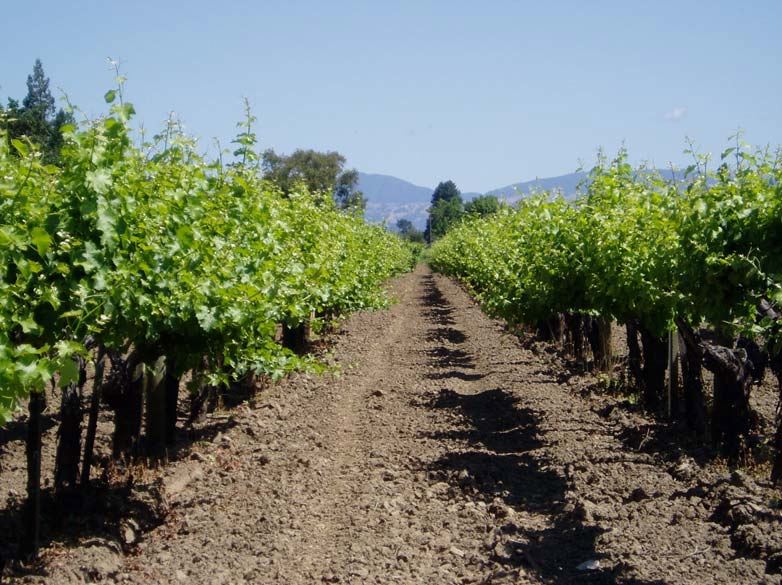
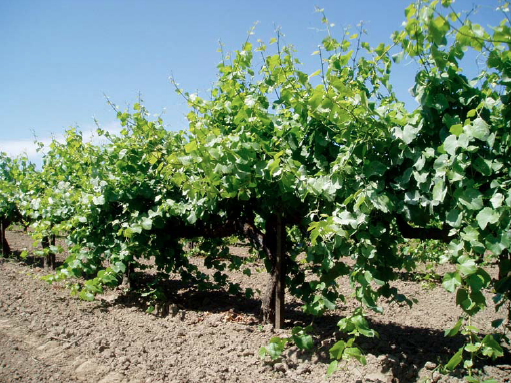
Several blocks of Pinot Noir were planted in subsequent years. Three Corner Vineyard, located on the southern end of the estate, was planted in 1974 with West Block Selection. This vineyard was originally part of the Allen Vineyard, but was deeded to Joe, Jr., as a favor for farming the Allen Ranch for many years. Little Hill Vineyard is 2.2 acres planted in 1985 from West Block cuttings and lies adjacent West Block. River Block consists of 13 acres of Pommard 4, 115 and 777, established in 1995 and situated along the Russian River. More recently, additional blocks have been planted on both sides of Westside Road with the blocks on the uphill side of Westside Road designated as Sweetwater Ranch (which make up a large percentage of the Estate Pinot Noir bottling). In these younger blocks and as replacement for vines in the older blocks, newer clones including Dijon 115, 667 and 777 and heritage selections such as Calera and Hanzell, and rare, unspecified field selections have also been planted. The vineyard has a dizzying array of rootstocks as well. A map of the Rochioli Vineyard on the Rochioli website shows the layout with dates of plantings and clones. Allen Vineyard, located north of Rochioli Vineyard across Westside Road, was initially planted in 1970 by Joe, Jr., and with later plantings now contains West Block Selection (Wente), UCD 4 Pommard and Dijon 115.
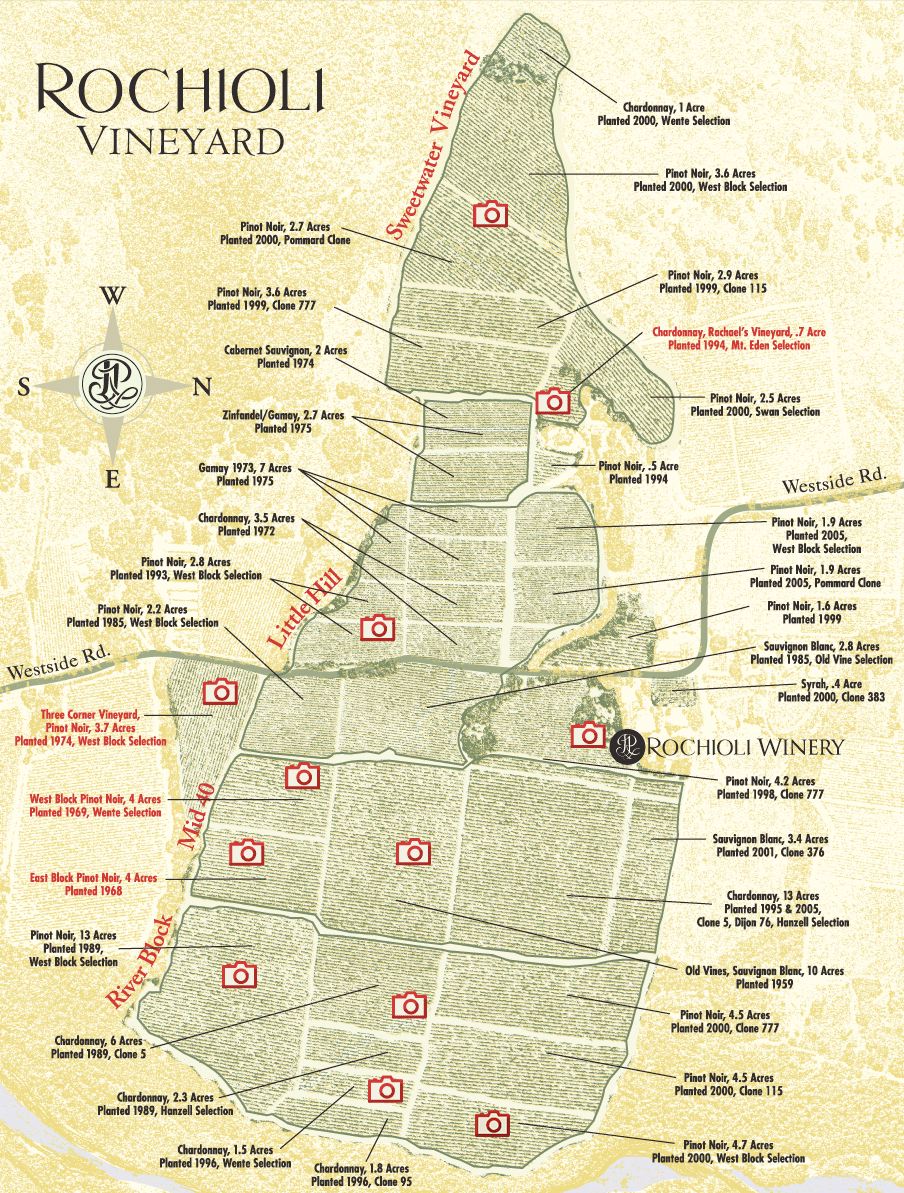 Today, of the ranch’s 160 acres, 128 acres (including the Allen Ranch which is a separate ranch with about 30 planted acres that Joe, Jr., farms as did his father before him) are planted with about 50% Pinot Noir. The heavily virused original East Block plantings have been completely replaced with West Block cuttings (the last vintage from the original East Block plantings was 2008) and a number of vines have been replaced in the West Block as well. West Block is now one-third of its original size. Joe, Jr., never thought he would have to remove any of his original plantings in his lifetime, but a number of funguses, viruses and other pests have ravaged the vineyards over time. Many Rochioli wine enthusiasts begged him not to pull the East Block vines out, but at production levels of less than one ton per acre, it simply did not make economic sense to preserve them. The first viable Pinot Noir crop from the Rochioli ranch was in 1971 and it was sent to a co-operative crush facility owned by E. & J. Gallo in Windsor. Until the late 1960s, all the grapes from Russian River Valley growers like Seghesio and Martini & Pratti went with those from Rochioli into what Joe, Jr., calls “Gallo garbage.” There were simply no other buyers for the grapes. Joe, Jr., recalls how sick he became when he had to send his beautiful Pinot Noir grapes from East Block and West Block to Gallo, who then proceeded to blend them with other varieties including Zinfandel and Petite Sirah from the Sonoma, Napa and Central California valleys to make his highly successful Hearty Burgundy. In Ellen Hawkes book, Blood & Wine, The Unauthorized Story of the Gallo Wine Empire, she states, “Hearty Burgundy was praised by some critics for its depth and complexity, and even gained popularity among ‘wine snobs’ who usually scorned the Gallo label.” Grape farmers in Northern California were not organized and were victimized by E. & J. Gallo. The growers would deliver their grapes to Gallo in September without a contract and no idea what they would be paid. In December of the vintage year, before property taxes were due, the farmer would receive a check in the mail from E. & J. Gallo who paid them whatever they wanted. By the mid 1960s, wine grape growers had formed the North Coast Grape Growers Association and fought this unfair practice of delivering grapes without an agreed-upon price. The farmers finally pressured E. & J. Gallo to commit to $100 a ton with a $5 bonus if the grapes were really premium. By the early 1970s, Joe, Jr., had some contracts for his grapes including Dry Creek Winery which bought his Sauvignon Blanc grapes, but he was selling most of his Pinot Noir to Korbell for their sparkling wines. Handshake agreements continued to be the rule, and it was to be a long time before a law was finally passed in California requiring a winery to have an upfront written agreement on the price they would pay the winegrowers for their grapes. In 1972, Davis Bynum, a San Francisco newspaper man, bought the 84-acre River Bend Ranch on Westside Road for a reported $115,000. The property had a hop kiln used for drying hops. Bynum converted the hops processing room next to the kiln into a winery and started Davis Bynum Winery. Bynum developed several handshake agreements with local farmers including Joe Rochioli Jr., Howard Allen and Rick Moshin. He bought Rochioli’s Pinot Noir in 1973 and from 1973 to 1979 was the only winery receiving Rochioli fruit. The 1973 Davis Bynum Winery Rochioli Vineyard Pinot Noir and 1973 Joseph Swan Pinot Noir were probably the first Pinot Noirs to carry the words “Russian River” on the label, ten years before the Russian River Valley AVA was approved. Bynum’s 1973 wine was the first Russian River Valley vineyard-designated Pinot Noir. Joe, Jr., still has a bottle of this wine today but he claims a 1978 Davis Bynum Rochioli Vineyard Pinot Noir is the best Pinot Noir he has ever tasted. Beginning in 1976, Joe, Jr., had Davis Bynum produce 2,000-3,000 cases of Pinot Noir and Chardonnay at Davis Bynum Winery under the Fenton Acres label. Three years later, he sold some West Block Pinot Noir grapes to Williams Selyem before that famous winery had become bonded. Burt Williams recalls that Joe, Jr., sold them their first Pinot Noir from the now-coveted West Block of his vineyard for $550 to $600 a ton. Williams Selyem made Rochioli Vineyard famous, when in 1987, the 1985 vintage Williams Selyem Rochioli Vineyard Russian River Valley Pinot Noir won the Sweepstakes at the California State Fair Competition and became the most seminal wine in the history of California Pinot Noir. The wine was sourced from the West Block but this was not evident on the label. 295 cases of this wine were produced and it was sold for $16 a bottle. A copy of the article that appeared in the Santa Rosa Press Democrat below.
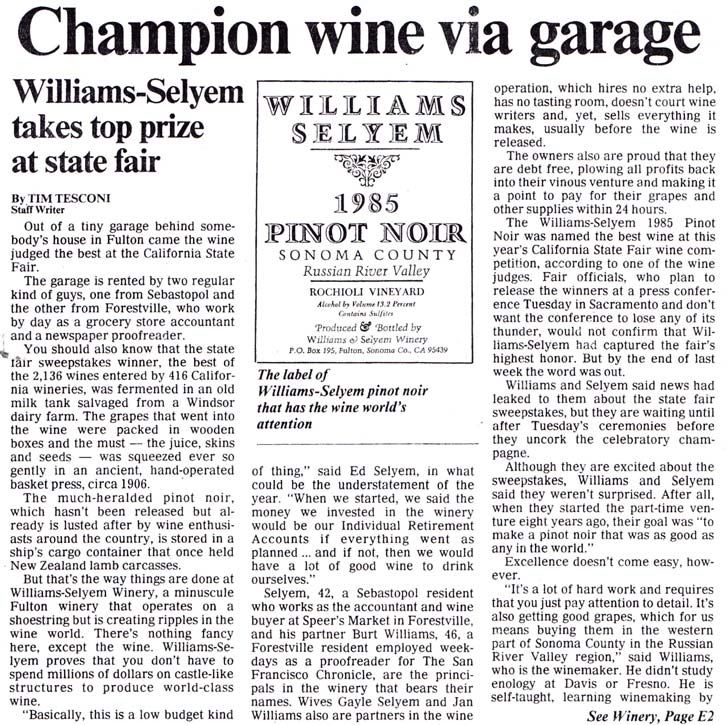 Williams Selyem continued to source West Block fruit until the winery was sold in 1997 after which time Williams Selyem received grapes from River Block
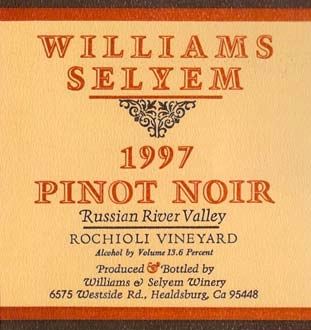 Gary Farrell, who had joined Davis Bynum as an assistant winemaker, made 50 cases of 1982 Rochioli Vineyard Pinot Noir from the West Block of Rochioli Vineyard and North Hill of Allen Vineyard to launch his Gary Farrell label. He has said, “It (Rochioli Vineyard) confirmed my opinion that world-class Pinot Noir could be grown in the Russian River Valley.” Also in 1982, Farrell crafted 150 cases of Pinot Noir for Joe Rochioli Jr., to start the Rochioli wine brand. Shortly thereafter, Joe, Jr.’s son, Tom, returned from the corporate business world, disenchanted with his job at Bank of America in Santa Rosa, and despite the lack of formal schooling in winemaking, soon became the winemaker, a position he has held ever since. Using Tom’s business acumen, and with winery design input from Gary Farrell, a 10,000 case winery was constructed on the Rochioli estate in time for the first crush in 1985, and Rochioli Vineyards & Winery was born. Joe, Jr., and Tom below. The winery was remodeled with specific rooms for red wine and white wine production and finished in 2009.
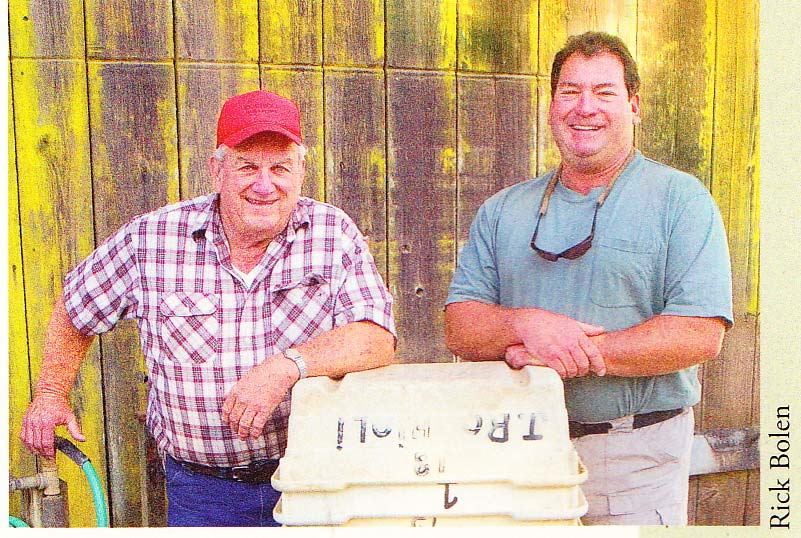 Tom’s biggest winemaking influence was Burt Williams, but he also had an intuitive sense about how the superb Rochioli fruit should be handled. His typical winemaking regimen is as follows. The Pinot Noir grapes are picked ripe and sorted both in the field and on the crushpad. Fermentations are carried out in small open top tanks with a short cold soak preceding inoculation with yeast. Punch downs are carried out by hand three times daily for about 8 to 10 days with MLF occurring in tank. The Pinot Noirs are kept in Francois Frères barrels (30% to 100% with the block designated Pinot Noirs receiving more new oak) on the lees for 8 months, then racked and blended, and returned to barrel for another 7 months until bottling. The wines are never fined and rarely filtered. Joe, Jr., is responsible for many important innovations in wine grape growing and in 2003 was awarded the prestigious Copia Wine Grower Of The Year Award. His ideas have come from intuition and common sense tempered by experience. He was one of the first to pull vine leaves to reduce vigor and open up the grape clusters to sunlight. He began doing this with Sauvignon Blanc and later with Pinot Noir and Chardonnay after realizing that it produced better quality wine. He became a leading proponent of limiting yields. The Pommard clone planted in the Rochioli Vineyard can produce five or six tons per acre when young, but Joe, Jr., found that although the grapes had acceptable sugar and acidity, they had poor color and flavor. Keeping yields under four tons per acre made a big difference. We know now from years of experience in viticulture that fruit thinning to limit yields can produce higher quality fruit. The benefits are not precisely defined, but seem to involve phenolic compounds and may lead to lower sugar levels at ripening. Joe, Jr., was one of the first and most adept field budders. Until the 1970s, all grafting was done in nurseries (so-called “bench graft”). With the widespread demand for vines, “field grafts” became the norm. Joe, Jr., was able to field graft an extraordinary 500 vines per day and through the years budded practically every ranch in the county. For years he traveled the back roads in his 1947 International Harvester pickup truck, top speed 35 miles-per-hour, to work in other vineyards. Owners simply would not trust anyone else to do the field grafting. Joe, Jr., was a tireless and devoted farmer who would arise at 4:00 A.M. and work 10 hours a day, 6 days a week. He remarked to me, “I was never in it to make a lot of money. I did it for pride. When somebody asks how we do it, I answer that it’s the combination of soil, climate, clones, instinct and farming practices.” He performed all the equipment repair and welding on the farm and built his own house on his property over a two year period, which his son, Tom, now lives in. He still looks healthy at 75, but has developed numerous physical ailments related to his years of hard labor in the vineyard and he has undergone a dozen surgeries. In spite of his infirmities, his spirit is evident and he continues to be in charge of the entire Rochioli vineyard holdings, working many hours most days of the week. Rochioli cellar master Terry Bering told me, “If he stopped, he would be dead!” When I visited him a couple of years back, he told me he had spurned vacations, rarely leaving his property, but had plans to take all his extended family of five children and eleven grandchildren to Hawaii. Joe, Jr., was married ten years and had two children before divorcing. His current spouse was married 25 years and had three children before divorcing. The two were high school sweethearts and eventually reunited and married. With about 900,000 vines planted on 128 acres, there is plenty of work involved in farming the Rochioli estate. Eight steady men have worked on the property for up to 25 years and intimately know the vines. The crop is thinned as many as five times during the growing season beginning with suckering in early spring and removing green grapes during veraison. Vines are lost every year and replanting goes on continuously. The perimetry of the vineyard is thick with brush and its proximity to the Russian River makes it vulnerable to pests. In recent years, the blue-green sharpshooter and mealybug have been the most voracious predators. About 60% of the grape crop at Rochioli is sold to others including Williams Selyem (River Block grapes are in the River Block designate and make up a portion of the Westside Road Neighbors bottling), Gary Farrell Vineyards & Winery, Alysian (Gary Farrell’s new winery), Portalupi, Solitude, and Castalia (Castalia’s Terry Bering has been the Cellar Master at J. Rochioli Winery since 1990 - refer to feature on Castalia in this issue). Castalia is the only producer currently allowed to specify “Rochioli Vineyard” as the grape source of the wine on the label. The J. Rochioli block designated labels simply identify the block such as “West Block” without specifying “Rochioli Vineyard.” There are over thirty wineries on the waiting list begging for Rochioli fruit including a number of the small prestigious producers of Pinot Noir in California. Joe, Jr., tells them they will never get any fruit, but they insist on putting their name on the waiting list. Cuttings from the vines are no longer sold or given away. A beautiful cluster of West Block Pinot Noir below.
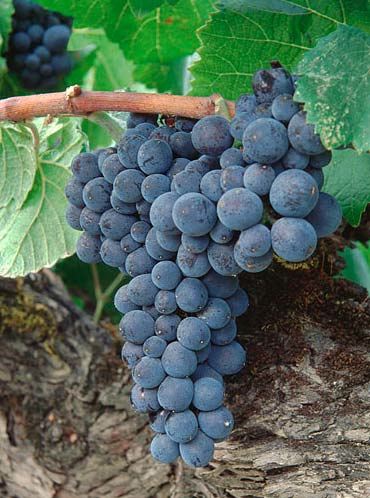 The estate blend of Pinot Noir (2,500 cases), the estate blend of Chardonnay, and the Estate Sauvignon Blanc (currently a blend of grapes from the original 1959 planting, a 17 year-old hillside estate planting and a rare clone of Sauvignon Blanc) are bottled under the Rochioli name, while the single-block vineyard-designated Pinot Noirs and designated Chardonnays are labeled as J. Rochioli. The classy labels have remained essentially the same through the years. An Estate Pinot Noir has been produced every year since 1982. A Reserve Pinot Noir consisting of a selection of barrels from the West Block was produced in 1986, 1988, 1990 and 1991. In 1988, it was labeled as Special Select. In 1992, the first of the block-designates debuted with the West Block and Three Corner Block Pinot Noirs. East Block was released separately in 1993, 1994 and then yearly since 1997 until 2008. Little Hill Block and River Block debuted in 1999 and the Sweetwater Vineyard Pinot Noir was offered for the first time in 2007. The five original single-block Pinot Noirs - East Block, West Block, Three Corner, Little Hill and River Block - were first offered together in 1999. Tom had visited Burgundy (Joe, Jr., never did) in 1990 and thought that the blocks were distinct expressions of terroir. He decided to model the vineyard after similar vineyards in say, Vosne-Romanee. After visiting Domaine Romanee-Conti, he remarked, “Here are these blocks of vines together in a small area on a slope that looks fairly uniform, yet the wine from each plot is unique and different.” Tom had noted differences in barrels from different plots of the Rochioli estate vineyard despite the vine material being similar, the cultivation identical throughout the five blocks, and the vinification of each plot the same. Each wine was recognizably distinct, reflecting differences in terroir similar to the subtle disparities in soil and microclimate that define the distinct terroirs of the Côte d’Or in Burgundy. The specifics of the 1999 J. Rochioli Pinot Noirs: East Block - 1.2 tons per acre, 150 cases, $85; West Block - 1.6 tons per acre, 400 cases, $65; River Block - 150 cases, $55; Three Corner - 100 cases, $55; Little Hill - 200 cases, $50. Joe, Jr., has never seen two vintages the same in all the years he has worked the ranch. He points out that the age ability of the wines reflects the vintage. Some years can age gracefully for well over ten years, while others seem to peak earlier. His Sauvignon Blanc is considered among the best in California, the Chardonnays are first-rate, and his Pinot Noirs are benchmark wines for Russian River Valley and California Pinot Noir. The Pinot Noirs have a consistent style of rich fruit that is succulent and spicy and tastes damned good. Some have raved about the wines in the literature: “Rochioli seems to be one of those rare American Pinot Noirs that both old school and new school Pinot lovers like. They have a deft touch never being too big, too oaky, or too concentrated, but always having lots of flavor,” and “Rich and concentrated, but remarkably pure and fresh,” and “The West Block Pinot Noir has a reputation for stylistic consistency, deep color, medium body, strong fruit and spice profile,” and “A liquid portrait of the Russian River Valley.” The estate Rochioli Pinot Noir, Chardonnay and Sauvignon Blanc are available through the winery’s tasting room with limited retail and restaurant distribution (distributor is Terlato Wines). Occasionally a special bottling is offered through the tasting room. The J. Rochioli Pinot Noirs are highly allocated to a mailing list which has a waiting list now extending out to five years. The wines are expensive (starting at $65 for the Estate Pinot Noir and reaching $100 for the J. Rochioli West Block Pinot Noir), but not relative to Burgundy standards for equivalent quality and pedigreed wines. Allocations reflect past purchases. Those not on the mailing list should look to the secondary marketplace for the J. Rochioli Pinot Noirs. A search for J. Rochioli West Block Pinot Noir on wine-searcher.com revealed1993 and 1996-2008 vintages were available at prices from just under $100 to $275. Library wines and magnums are occasionally offered to mailing list members. Only 12-24 magnums of each block designated Pinot Noir are produced each year. Production of the Rochioli Estate and J. Rochioli Winery wines is about 12,000 cases. Pictured below are the labels for the 2009 Rochioli and J. Rochioli Pinot Noirs. Production figures for the 2009 wines were as follows: Estate Pinot Noir (75% Sweetwater Vineyard and 25% various sites in the Rochioli estate; 3,559 cases, $65), Sweetwater Vineyard (3 tons per acre, 350 cases, $72), Little Hill (2.8 tons per acre, 350 cases, $72), River Block (2 tons per acre, 125 cases, $72), Three Corner Vineyard (1.0 tons per acre, 200 cases, $80), and West Block (1.3 tons per acre, 200 cases, $100). Production figures have varied considerably over the past decade because a significant number of vines have been replaced, newer plantings have come online, and in some vintages not every block designate was bottled.
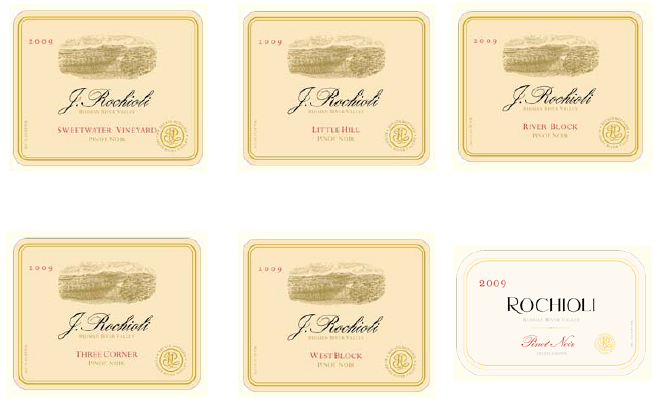 Additional production is on the horizon as West Block came into full production in 2011, the replanting of Little Hill and River Block has been completed, East Block has been replanted and will return to production, and the first crop from Big Hill, a rocky hillside site planted to West Block Selection and ten rows of a rare field selection was first harvested in 2011. This Big Hill block may turn out to be the “grand cru” site in the Rochioli Vineyard. The winery and tasting room is located at 6192 Westside Road in Healdsburg. Tasting is offered Thursday thru Monday from 11:00 to 4:00 (Tuesday and Wednesday by appointment). Winery tours are available Tuesdays and Wednesdays by appointment. The tasting room is closed the last 2-3 weeks of December. Father and son Rochioli cherish their privacy and rarely offer their wines at Pinot Noir themed events. The website offers modest detailed information: www.rochioliwinery.com.
 View an video interview of Joe Rochioli, Jr., filmed by Grape Radio for Williams Selyem Winery within the past few years: www.williamsselyem.com/videos/Video-Rochioli.html.
Tasting J. Rochioli Pinot NoirIn July 2005, I hosted a vertical tasting of 1992-2002 J. Rochioli West Block Pinot Noir at Mr. Stox Restaurant in Anaheim, California. It was a spirited evening marked by celestial Pinot Noir attended by members of my wine club, Le Grand Crew, composed of a number of luminaries including, John “Dookey” Maggiano, Ed “Big Boy” Buckley, Art “Deep” Fries, Steve “Slide Rule” Dember, Chuck “Cereal” Keller, Mike “Cash & Carry” Cohen, and Rene “Master Somm” Chazottes. A number of general observations about the wines were agreed upon by most of those present. All the wines had aged beautifully with no sign of appreciable oxidation. Some wines were distinctly better, but there were no bad wines in the lineup. Aromatically, the wines offered fresh fruit aromas, an impressive mid palate attack of luscious and deeply concentrated Pinot fruits, soft textures, appealing charm and impressive balance. The younger wines were bigger with fresher fruit and a little more demonstrative oak. The one criticism of the assembled that was leveled at the lineup was the short finish of the wines, a shortcoming that kept the wines from being rivals of great Grand Cru Burgundy. Still, these were vinous treasures that made a lasting impression. The following were my brief tasting notes that evening. The two food courses were grilled Sonoma quail with duck confit on a roasted butternut squash puree and garlic reduction, and a rack of venison with peppered Yukon Gold potatoes and black trumpet mushrooms.
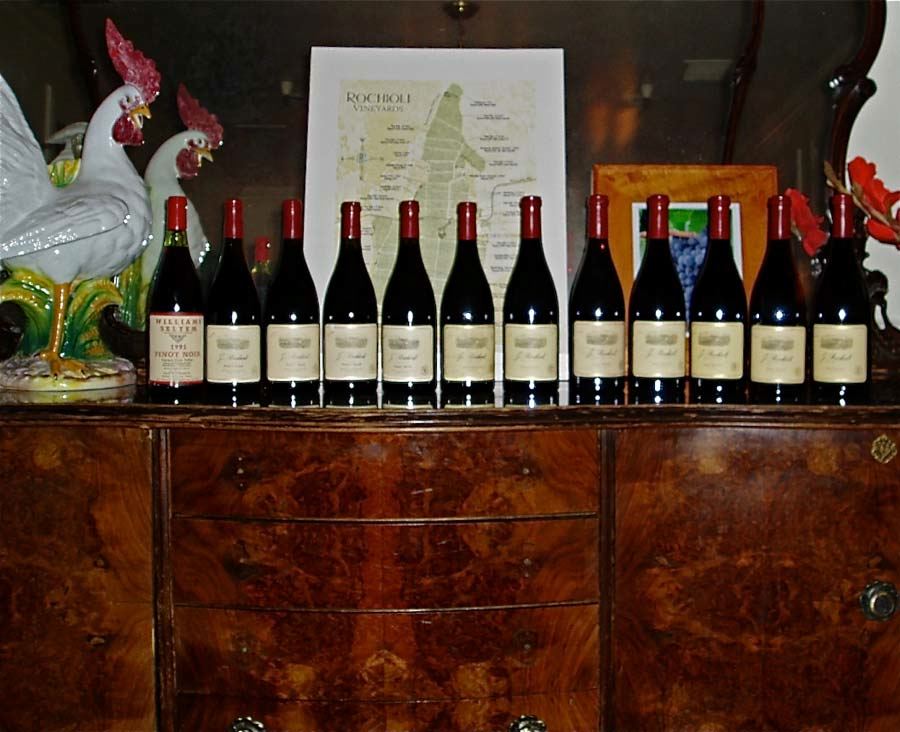 Recently I tasted a vertical of J. Rochioli West Block Pinot Noir 1997-2008 (2004 and 2005 are missing as I expected to receive these two vintages in time for the tasting. They will become available soon and the results added later). I also tasted a few vintages of J. Rochioli East Block Pinot Noir (2000, 2001, 2003, 2004), J. Rochioli Little Hill Pinot Noir (1999, 2002, 2003), J. Rochioli Three Corner Pinot Noir (2001, 2002), and one vintage of J. Rochioli River Block Pinot Noir (2003). Preceding my notes are Tom Rochioli’s tasting notes from 2010. Some vintages of the West Block and East Block Pinot Noirs are spectacular. The wines age very well, easily holding their own for over ten years. When the bottles are opened, a striking aroma waifs from the glass, and the wines, while demanding your attention upon pouring, develop nuances and improve over time in the glass. Decanting is advisable for all but the oldest wines. The wines reflect their origins from a relatively warm part of the Russian River Valley (Middle Reach). They are packed with very ripe fruit but retain an appealing freshness and elegance.
“Many of our customers have asked how the wines will age. The standard answer has been six to eight years for our Pinot Noir to reach its peak. I am starting to think that this is the minimum. Many vintages can far exceed the eight-year mark. I will cover the single-vineyard wines from 1999 to 2006. The wines have been stored in a climate-controlled room at an average of 58 degrees and 70 percent humidity. I should mention that wines in magnums are drinking much younger than the bottles. My guess at least a year. Also, every wine seemed to evolve and improve after being opened for a while. Decanting is recommended.”
West Block 1999: Tasted March 2010. Starting to show its age with a slight brick edge but still has a deep red color. Perfumed anise tea and red fruit combine with a long, almost sweet finish. This wine aged nicely. Drink now to 2011. 2000: Tasted February 2010. Dark red with full developed aromas of rose petal, anise, cherry and oak. The berry flavors are rich and the structure is sound and quite enjoyable. Drink now to 2011. 2001: Tasted March 2010. Dark red, with some signs of age. Sweet cherry fruit with the classic anise aroma in the background. Little oak influence in the nose or mouth. Almost sweet fruit with firm acidity and refined tannin. Drink now to 2011. 2002: Tasted June 2010. Dark red with little signs of aging. Ripe cherry aromas with slight hints of vanilla. Full-bodied and medium tannin are combined with soft acidity. This wine still displays signs of youth and should have a promising future. Drink now to 2012. 2003: Tasted June 2010. Lighter in color than the previous year but still on the dark side. A rich red with a slight light brick edge. Sweet red fruits combine with rose petal and spice. The flavors are sweet, balanced and ready to drink. Drink now. 2004: Tasted March 2010. Dark red with little signs of age. Nice aromas of black cherry, anise, smoke and dried flowers. Full rich body and firm acidity that indicates future aging. This was a vintage that was very ripe and extracted and may be one of my favorites. Drink now to 2010. 2005: Tasted September 2010. Dark red color with signs of purple. Ripe aromas of black cherry, anise, and vanilla. Rich flavors of berries combine with a touch of oak that finish full and smooth. The tannin is still showing its youth and the acidity is balanced. Although delicious now, it should show well from 2011 to 2014. 2006: Tasted June 2010. Dark red color. Ripe cherry aromas with slight hints of anise and vanilla. Full-bodied and rich tannin are combined with soft acidity. This wine still displays signs of youth and’ should have a promising future. East Block 1999: Tasted August 2010. Dark red with a slight brick edge. Ripe cherry fruit with a distinct terroir quality from this unique site. Rich and full-bodied with some tannin and nice acidity. It is still hanging on. Drink now to 2011. 2000: Tasted July 2010. Rich dark red with a slight brick edge. Ripe black cherry fruit with a distinct earthy quality from the site. Rich and full-bodied with soft tannin and nice acidity. It is holding up well. Drink now to 2011. 2001: Tasted August 2010. Dark red color. Dark berry fruit with the familiar herbal touch that early East Block possesses. Rich flavors of berries with a touch of spice and vanilla. Long, full mouthfeel that still has youthful acidity. Drink now to 2011. 2002: Tasted August 2010. Dark red color. Very rich cherry fruit with the familiar herbal quality East Block wines possess. Rich flavors of berries with a touch of spice and vanilla. Long, full mouthfeel that still has firm acidity. Drink now to 2011. 2003: Tasted August 2010. Rich red with a brick edge. Ripe cherry fruit with a distinct herbal quality. Ripe, rich and full-bodied with dry tannin and nice acidity. The wine is drinking well and should be consumed now. 2004: Tasted June 2010. The same dark red as the West Block with the slight bricking on the edges. Cherry, tobacco, and spice aromas that match well with the full ripe berry flavors. This is also one of the top wines I have tasted. Drink now to 2012. 2005: Tasted September 2010. Dark ruby with no signs of age. Black cherry, tea, and the classic herbal quality that leans more toward earthy than stems. Rich full mouthfeel with flavors that persist with an almost sweetness. Firm acidity and graceful tannin. Drink 2011 to 2014. 2006: Tasted August 2010. Dark red color. Very rich black cherry fruit with the familiar herbal quality with rich flavors of berries with a touch of spice and vanilla. Very youthful, this wine has a full mouthfeel with firm acidity. Drink now to 2013. Three Corner Vineyard 1999: Tasted August 2011. Lighter in color than the East Block. Still showing signs of age but with a more floral quality than cherry. Anise, subtle oak is also in the aromas. Medium body with a full rich finish. Drink now. 2000: Tasted February 2010. Fully developed with sweet cherry, earth and vanilla aromas. Slightly dry on the palate with little tannin and nice acidity. Drink now. 2001: Tasted August 2010. Rich red color with a slight brick edge. Aromas of ripe fruit but more like strawberries than cherry, vanilla and a background of potpourri. The rich berry flavors and crisp acidity have a medium finish. Drink now. 2002: Tasted June 2010. Medium red in color. Perfumed aromas of cherry and vanilla. Medium-bodied with berries and cream with soft tannin and mild acidity. Very charming. Drink now. 2003: Tasted July 2010. Rich red color with a touch of brick on the edge. Cherry fruit pokes through a complex array of aromas that include tea and spice. Medium-bodied, but the finish lingers with soft tannin and acidity. This is typical of the vintage. Drink now. 2004: Not produced 2005: Tasted June 2010. Medium red color. Perfumed aromas of cherry and vanilla. Full-bodied with berries and cream with soft tannin and mild acidity. Drink now to 2013. 2006: Not produced
Little Hill 1999: Tasted June 2010. Medium red in color. Spicy aromas of pepper combine with blackberries and earth. The mature flavors are medium-bodied, with firm tannin and mild acidity. Drink now. 2000: Tasted June 2010. Dark red in color. Spicy aromas of cherry and pepper combine with berry and earth flavors. Full-bodied with firm tannin and mild acidity. Drink now. 2001: Tasted June 2010. Dark red color. Aromas of potpourri, blackberries and earth. Rich and full on the palate with firm tannin and mild acidity. The vineyard is starting to show well. Drink now. 2002: Tasted June 2010. Dark red color. Complex aromas of wet stones combine with black cherry and earth. Full-bodied, with firm tannin and mild acidity. This vintage of Little Hill is holding up nicely. Drink now to 2011. 2003: Tasted July 2010. Dark red color with some bricking. Aromas of wet stones combine with the typical blackberry fruit of the vineyard. Medium-bodied with a long lingering finish with soft tannin and solid acidity. This reminds me more of a 1er Cru Volnay than Russian River Valley. Drink now. 2004: Tasted June 2010. Rich dark red color. Cherries and earth aromas with an underlying mineral quality. Medium-bodied with rich tannin and nice acidity. This may be the sleeper of the vintage. Drink now to 2012. 2005: Tasted June 2010. Dark red color. Complex aromas of ripe cherry and the usual mineral quality, combine with rich berry flavors. Full-bodied with firm tannin and mild acidity. This vintage of Little Hill is holding up nicely. Drink now to 2014. 2006: Tasted July 2010. Medium to dark red color. Minerals, ripe blackberry and spice aromas. Medium to full-bodied with lingering flavors. The tannins are firm as usual and should age well. Drink 2011 to 2012.
River Block 1999: Tasted June 2010. Deep red color with slight bricking. Aromas of ripe cherry and mint combine with floral overtones. The tannins are apparent but soft and the acidity is brisk. Drink now. 2000: Not produced. 2001: Tasted March 2010. Deep red color with noticeable bricking. Aromas of ripe fruit and vanilla combine with floral overtones. The tannins are soft and the acidity is still apparent. Should be best to drink now. 2002: Not produced. 2003: Tasted March 2010. Deep red color with brick edges. Aromas of ripe cherry and tea combine with floral overtones. The tannins have mellowed and the acid is soft. Drink now. 2004: Tasted June 2010. Deep red color with some signs of age. Floral aromas of ripe cherry, smoke and vanilla combine with ripe berry flavors. Very elegant. This wine is aging gracefully and should be consumed now to 2012. 2005: Not produced.
2006: Not produced.
Note: many wines below have a stated alcohol of 14.2% on the label, but I sense the honest alcohols are higher than this. I did not have a copy of Tom Rochioli’s tasting notes when I sampled the following wines. The West Block and East Block Pinot Noirs are clearly the class of the offerings. I should qualify my reviews with the admission that evaluating older wines is different from rating newer releases and is often dependent on the reviewers' predilection for aged wines.
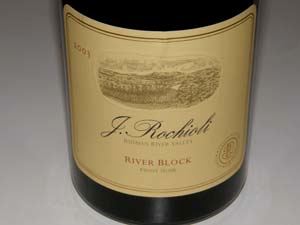 2003 J. Rochioli River Block Russian River Valley Pinot Noir 14.2% alc.. · Moderate reddish-purple color in the glass. Very enticing with aromas of fresh black cherries, spice, underbrush, shaved oak and sandalwood. Red fruits are featured with some underlying earthiness and oak. Soft in the mouth with supple tannins. A touch of heat on the finish. Very good.
1999 J. Rochioli Little Hill Russian River Valley Pinot Noir 14.2% alc., 200 cases, $50. · Moderate reddish-purple color in the glass. Subdued fruit aromas with prominent smoky oak and horsey (Brett) notes. Medium weighted core of dark red fruits that have fallen off and concede to the notable tannin, oak highlights and earthiness. Drink up. Decent.
2002 J. Rochioli Little Hill Russian River Valley Pinot Noir 14.2% alc.. · Moderate reddish-purple hue in the glass. Alive with black cherry fruit, spice and toast, picking up intensity with time in the glass. Fading black fruits with underpinnings of earth, oak and anise. The structure supersedes the fruit with very bright acidity (citrus peel) on the finish. Drink up. Good.
2003 J. Rochioli Little Hill Russian River Valley Pinot Noir 14.2% alc.. · Moderately light reddish-purple color in the glass. Attractive perfume of cherries and berries with hints of oats, raisin, and coconut. Modestly intense core of black raspberry, blackberry and black cherry fruit with a tarry, earthy bent. Fruit is on the riper side. Well-proportioned tannic backbone, smoothly textured, ending with a little heat. Drink up. Good.
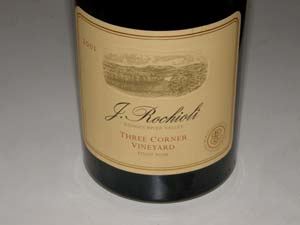 2001 J. Rochioli Three Corner Vineyard Russian River Valley Pinot Noir 14.2% alc.. · Moderately dark reddish-purple color in the glass. Well-endowed nose with many nuances including aromas of black cherries, cola, spice, cut grass and oak. Delicious core of black cherry, black raspberry and black current fruit of modest intensity with hints of earth and anise, persisting on the somewhat lengthy dry finish. Holds up well over time in the glass, even improving. Will last a few more years. Very good.
2002 J. Rochioli Three Corner Vineyard Russian River Valley Pinot Noir 14.2% alc.. · Moderately dark reddish-purple color in the glass. Shy aromas of cherry pie filling, forest floor, barnyard, oak and vanilla, picking up intensity in the glass over time. Medium-weighted core of dark stone and berry fruits with subtle oak and herb highlighting. Well-structured with fine-grain, soft-coating tannins and credible balance. Plenty of life to go another few years. Very good (+).
2000 J. Rochioli East Block Russian River Valley Pinot Noir 14.2% alc.. · Very dark purple in the glass. Very fruity upon opening displaying scents of blackberries, plums, earth and oak, becoming more savory in the glass over time exhibiting aromas of wooded forest and mushrooms. A slight bit of Brett peaks out. Dense, intense and darkly fruited with a complimentary note of savory herbs. The fruit is well clothed in fine-grain tannins and lively acidity. Drink up. Good (+).
2001 J. Rochioli East Block Russian River Valley Pinot Noir 14.2% alc.. · Dark reddish-purple color in the glass. Aromas of dark cherry tart, roasted nuts, Herbs de Provence and vanilla. Well-endowed with dense, dark and voluptuous fruit with an underlying earthiness. Good underlying acidity and some persistence on the fruit-filled finish. A bit blocky. Drink up. Good.
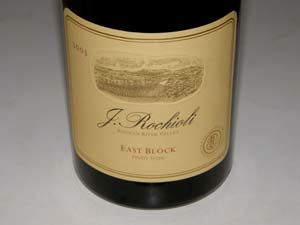 2003 J. Rochioli East Block Russian River Valley Pinot Noir 14.2% alc.. · Moderately darkly colored in the glass. Gorgeous aromatics offering hi-strung aromas of spiced cherries and black raspberries with a complimentary floral and spice box note. Bright and persistent on the palate while displaying a luscious core of perfectly ripe and earth-kissed black cherries and berries encased in lively acidity. Very polished, classy and harmonious. Still has a few years of life if well cellared.
2004 J. Rochioli East Block Russian River Valley Pinot Noir 14.2% alc.. · Dark reddish-purple color in the glass. Shy dark fruits on the nose with savory aromas of herbs, wet bark and oak. Very tasty essence of black cherries, intensely flavored on the mid palate, with notable persistence on the long finish. The fruit veers to the ripe side but is irresistible in its racy quality. A striking wine that possesses impeccable balance, old vine fruit pedigree, and seductive drink ability. Slightly better than the 2003 vintage and will drink nicely for another five years.
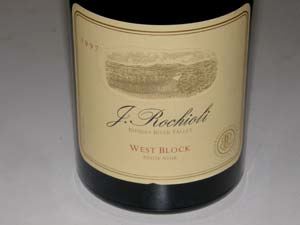 1997 J. Rochioli West Block Russian River Valley Pinot Noir 13.5% alc., $60. Yield 2.75 tons per · Moderately dark reddish-purple color in the glass with a slight brickish rim. Aromas of brooding dark fruit, wood pile, underbrush, anise and dark chocolate. Ripe fruit flavors of black cherries and plums with accents of baking spice and anise. Still fresh in the mouth, displaying powdery tannins and good acidity on the short finish. Definitely has an aged patina but impressive for a 14 year-old wine. Fruit has begun to fade and intensity is the least of all the wines to follow. Drink up. Very good.
1998 J. Rochioli West Block Russian River Valley Pinot Noir 13.5% alc., 400 cases, $60. Yield 1.8 tons per acre. · Moderately dark reddish-purple color with a slight brickish rim. Aromas of black cherries, underbrush, leaf, mushroom, cardamon spice and sweaty horse (Brett). Medium-weight black cherry and cassis flavors make an impression. Smooth in texture with mild fine-grain tannins and a moderately long finish. Drink up. Very good (if you don’t mind a little Brett).
1999 J. Rochioli West Block Russian River Valley Pinot Noir 14.2% alc., 400 cases, $65. Yield 1.6 tons per acre. · Moderately dark reddish-purple color in the glass. Meager fruit on the nose but interesting aromas of dried leaf, yeast, oak, char, sandalwood and old book. Woody and earthy, featuring black raspberry jam flavor with hints of tea and cola. Concentrated and bold with tannins overshadowing the fruit. Improves in flavor over time in the glass. A big-fruited wine that should be drunk up. Good (+)
2000 J. Rochioli West Block Russian River Valley Pinot Noir 14.2% alc., 400 cases, $65. Yield 1.9 tons per acre. · Dark reddish-purple color in the glass. Lovely aromas of dark berry jam, dried rose petals, leaf, oak and exotic woods. Impressive attack of black cherry, blackberry and black plum fruit wrapped in sturdy tannins. A charming wine with strikingly flavorful fruit (finesse with power) that persists on the long finish. Could last a few more years. Very good (+).
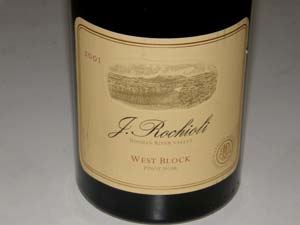 2001 J. Rochioli West Block Russian River Valley Pinot Noir 14.2% alc., 400 cases, $65. Yield 1.8 tons per acre. · Moderately dark reddish-purple hue in the glass. A nose you could drink with bright aromas of cherry pie filling, roasted nuts, mocha and sandalwood. Very silky and seductive on the palate with anise-flecked black cherry fruit that is vivid and pure. Very fresh and alive with moderate tannin and impressive finishing power. Will be impressive a few more years.
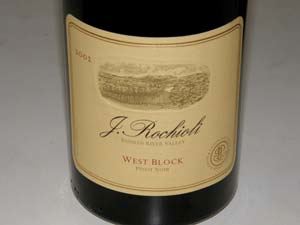 2002 J. Rochioli West Block Russian River Valley Pinot Noir 14.2% alc., 400 cases, $70. Yield 1.8 tons per acre. · Moderately dark reddish-purple color in the glass. A bombastic perfume of spiced black cherries leaps out of the glass when the cork is pulled. Scents of smoke, oak and anise add interest. Luscious, full-bodied and broad in the mouth. Blessed with delicious black cherry, baking spice, and Hoison plum sauce flavors, with accents of earth, oak and tobacco. Soft and silky with bright acidity, supportive tannins, and an ending Hollywood would be proud of with memorable persistence of fruit on the dry, juicy finish. Even better later in the day from an opened and re-corked bottle. Will last several more years if properly cellared.
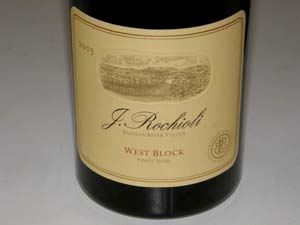 2003 J. Rochioli West Block Russian River Valley Pinot Noir 14.2% alc., 200 cases, $70. Yield 1.0 tons per acre. · Moderate reddish-purple color in the glass. Good aroma volume with scents of dark red berries, crushed strawberries, cherries, earth and vanilla. Vibrant and fresh on the nose. Similar to the 2002 vintage, but a little less extracted, a little crisper and a little redder-themed in the fruit profile. Notes of earth, rosehips tea and anise add interest. Like the 2002 vintage, a very long finish of sweet plum is memorable. Aristocratic feel in the mouth with mild, firm tannins. Picks up intensity and interest over time in the glass and better later in the day from an opened and re-corked bottle. Balance predicts that this wine will maintain its nadir for a few more years.
2004 J. Rochioli West Block Russian River Valley Pinot Noir 400 cases. Yield 1.4 tons per acre. · Review pending.
2005 J. Rochioli West Block Russian River Valley Pinot Noir 14.5% alc., 400 cases, $78. Yield 1.8 tons per acre. · Medium reddish-purple color in the glass. Aromas of black cherries, bonfire, woodshed, tea leaf and herbs. Black-cherry driven, and seemingly a tad unripe, with a shallow mid palate, leaving behind a herbal and woody note in its wake. Atypical for West Block with the fruit lacking intensity and buried in oak and some tannin. May be an off bottle. Reserve judgment.
2006 J. Rochioli West Block Russian River Valley Pinot Noir 14.4% alc.. · Moderate reddish-purple hue in the glass. Intense aromas of very ripe cherry and berry fruit initially, fading some over time in the glass with a pruny note emerging and a slight bit of alcohol peaking out. A full mouth feel of sweet, dark Pinot Noir fruit bordering on over ripeness. Slight oak and dried herbs add nuance in the background. Despite its heft, the wine retains a commendable elegance. Bright acidity frames the finish which leaves a little heat in its wake. Good. 2nd bottle tasted in 2012. Medium reddish-purple color in the glass. The nose sports ripe dark red fruit aromas with spice. Full mouthful of luscious dark red stone and berry fruit. Very polished with soft tannins, faint oak, and a good cut of acidity on the finish. A charming wine that is seamless with impressive length on the glorious finish. Very good (+).
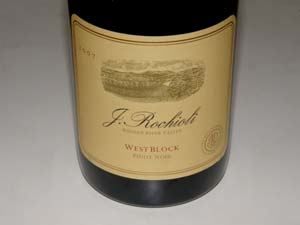 2007 J. Rochioli West Block Russian River Valley Pinot Noir 14.5% alc., $90. Yield 1.0 tons per acre. · Moderately dark reddish-purple color in the glass. Muted aromas of dark cherries and berries, oak cask, rose petals and vanilla pod which unfold slowly in the glass. Incredible, mouth coating dark stone and berry fruit, balanced with soft, sturdy tannins and lingering appealingly on the aromatic finish. The wine is still tight, but clearly, the fruit is perfectly ripe and the oak is beautifully integrated. This is an amazing, off-the-charts Pinot Noir that in five to ten years will be the star of your cellar. Figure out a way to get your hands on a few bottles of this beauty. Spectacular later in the day from a previously opened and re-corked bottle.
2008 J. Rochioli West Block Russian River Valley Pinot Noir 14.5% alc., 200 cases, $100. Yield 1.4 tons per acre. · Moderately light ruby red color in the glass. Reluctant aromas of Bing cherries and spice. Reddertoned cherry and berry fruit with hints of savory herbs, red hard candy and sandalwood. Less extraction than previous vintages, but still a beautiful wine that is more forward than the 2007 vintage and seduces with its soft mouth feel. Ends with a tug of bright acidity and flavor of Ben & Jerry’s Cherry Garcia. Very good.
Castalia Pinot Noir: Rochioli TooThere are a fair number of pinotphiles who cherish J. Rochioli Pinot Noir, but who are desperately biding their time on the waiting list, hoping to receive an allocation in the future. Listen up. There is one other option for you. I am hesitant to rave about it because the wines are still somewhat readily available, a situation that will undoubtedly change when the word gets out. Castalia, a small production label (less than 400 cases), currently sources fruit from Rochioli’s treasured West Block selection in River Block and Flax Vineyard and the resultant wines crafted by Rochioli Winery & Vineyard’s Cellar Master, Terry Bering, are crazy good and still relatively affordable. Terry Bering began as a home winemaker in 1983-1984, crafting Cabernet Sauvignon with friends in a Healdsburg carport. Terry admits the wines weren’t very good. He decided to try his hand at Pinot Noir and obtained 5-10 gallons of second crop grapes in the 1985 vintage and purchased grapes in the 1986 vintage. Both wines were early drinking Pinot Noirs made without new oak and were “great.” After meeting Tom Rochioli, Terry worked harvest at Rochioli Winery & Vineyards in 1988 and 1989, obtaining second-crop grapes from Three Corner Vineyard and crafting Pinot Noir that impressed the Rochiolis. Terry gladly left his real estate job when he was offered the position of Cellar Master at Rochioli in 1990 to assist Tom Rochioli. Today he is the only person working at the winery outside of Tom and is an unsung contributor to the success of the winery. Initially, the winery could only pay him $1,200 a month, so he was offered the opportunity to make a small amount of wine under his own label at the winery. He started with 150 cases in 1992, slowly increasing production to 352 cases in 2009. The wines are 100% Rochioli fruit and he is permitted to state, “Rochioli Vineyard,” on the Castalia label (the only producer so anointed). The name, Castalia, refers to a legendary spring on Mount Parnassus in ancient Greece that was favored by Apollo and was said to bestow gifts of poetry and inspiration on those who drank from its waters. From 1992 to 2003, up to 50% of the grapes were second-crop from West Block and about 50% first-crop from River Block. Terry told me, “Second crop grapes from West Block were great and the 2002 Castalia Pinot Noir was a revelation to many wine critics.” By 2004, he was receiving all first-crop including 50% from a 20-year-old block at Flax Vineyard (a vineyard on Westside Road planted from West Block cuttings and farmed by Joe Rochioli, Jr.) and 50% from River Block. With this change in 2004, Terry remarked that the Castalia wines were noticeably “kicked up,” and the 2004 and 2007 vintages were heavily lauded by the wine press. It is clear in talking with Terry that he has a special reverence for Rochioli fruit and takes his responsibility seriously of showing off the quality of the grapes in his finished Castalia wines.
As you can see by the quality of the 2002-2004 wines reviewed below, second-crop from a quality vineyard can make very decent wines, but second-crops are almost never used today at wineries. They follow the lead of the Bible, Leviticus 19:10: “Do not go over your vineyard a second time or pick up the grapes that have fallen. Leave them for the poor and the alien.”
Until 2001, he had to bottle his wines after 9 to 10 months because he could not afford barrels. Since then, he has been able to acquire barrels to allow him to hold the wines an extra 4 months (the wines have been barrel-aged 15 months since 2001). Terry says, “This makes a big difference as the wines are much more stable in bottle.” Recently, Terry gathered some fans of his wines and tasted a vertical of Castalia Pinot Noir dating back to 2000. The wines had aged beautifully. He prefers to drink the wines when they are five years old at which time he considers the flavors are at their peak and the wines are very supple. The Castalia Pinot Noirs are carbon copies of J. Rochioli block designated Pinot Noirs, but I feel offer more appealing drink ability early on. That said, the wines still benefit from decanting when young. The pedigree of Rochioli fruit shines in these well crafted beauties. I have been a fan since the 2002 vintage and first wrote about Castalia in the PinotFile in 2004. Recently I had the opportunity to sample a vertical of Castalia Pinot Noir, 2002-2009, and the results left me with even more heightened enthusiasm for the excellence of the wines. These special wines have impeccable balance and stunning finishing length. The wines will easily age 10 years. If you can’t get J. Rochioli Pinot Noirs, Castalia is the next best thing and the wines offer superb value as well (the 2009 vintage is $55). Castalia wines are sold through the website in 6 and 12 bottle lots in an old school manner (download the order form on the website, e-mail Terry at dboss@castaliawines.com to reserve your wines, and followup with a check and order form by snail mail). You can also call Terry at 707-857-3376. The 2009 vintage was released February 1, 2011, and is in limited supply. Magnums are produced but sell out immediately. The 2010 vintage yields were down by 50% so this vintage will be in even scarcer supply. Visit the website at www.castaliawines.com. There is limited distribution to fine wine retailers within California. Castalia Pinot Noir is on the wine list at Boulevard, Farallon and One Market restaurants in San Francisco.
In June 2011 I had the opportunity to sit down and chat with Terry over a bottle of 2009 Castalia Pinot Noir.
Listen to the audio: "Interview with Terry of Castalia"
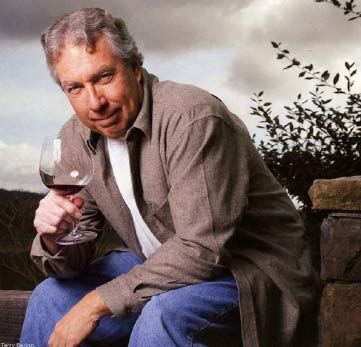 The 2000 and 2001 vintages were not tasted by me but were opened as part of another vertical tasting this year. I have included Terry’s comments on those two vintages. Castalia labels state alcohol as 14.1% but the honest alcohols are included here. Terry feels the intensity of the fruit can balance the higher alcohols and I found that to be the case in this tasting. He notes that grapes from West Block scion have to be ripe to bring out the flavors. The clusters are remarkable with some berries smaller than blueberries creating intense fruit flavor. These wines have remarkably intense fruit flavors but the wines offer finesse over fruit heaviness or jaminess.
2000 Castalia Rochioli Vineyard Russian River Valley Pinot Noir 14.94% alc., pH 3.64, 300 cases, $35. 50% River Block first-crop and 25% each of River Block and West Block second-crop. · Wellstructured with full flavors. B+.
2001 Castalia Rochioli Vineyard Russian River Valley Pinot Noir 14.44% alc., pH 3.58, 317 cases, $35. Same vineyard blend as 2000. Warm summer, cool September so harvested later. · Denser and took longer to develop. More structured, French-like. A-.
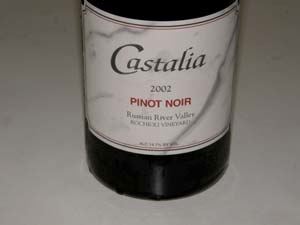 2002 Castalia Rochioli Vineyard Russian River Valley Pinot Noir 14.1% alc. (no honest alcohol or pH), 323 cases, $40. Composed of 60% River Block first-crop and 40% West Block second-crop. Perfect season. A 96 pt wine. · Moderately light reddish-purple color in the glass. Complex and alluring nose offering scents of black cherries, sweet pipe smoke, mocha, gingerbread, leaf and underbrush. Intensely flavored with a dense core of black cherry and cranberry fruit. Dreamy soft on the palate with supple tannins and impeccable balance. So fresh and lively, hard to believe the wine was 9 years old. Finishes with a memorable fruit-driven persistence. An amazing, orgasmic experience.
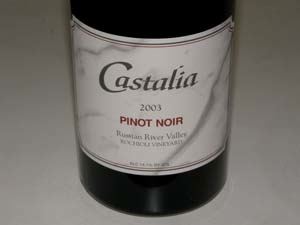 2003 Castalia Rochioli Vineyard Russian River Valley Pinot Noir 14.1% alc. (no honest alcohol), pH 3.51, 309 cases, $40. Same vineyard composition as 2002 vintage. Warm growing season. · Moderately light reddish-purple color in the glass. Very enticing aromas of pie cherries, berry jam, red candies and a hint of mocha. The wine attacks the mid palate with a vengeance, serving up layers of black cherry and dark red berry fruit set off by hints of cola and sassafras, lingering on the finish for nearly a minute. Beautiful balance, restrained tannins and light on its feet. Finesse with power. Slightly less weighted than the 2002 vintage, but a highly praiseworthy wine in its own right.
2004 Castalia Rochioli Vineyard Russian River Valley Pinot Noir 15.18% alc., pH 3.53, 320 cases, $45. First year with no second-crop and first year of fruit from Flad Vineyard West Block clone. · Moderately light garnet color in the glass, apparently unfiltered. Impressive aromatic intensity with scents of red berry cobbler, candied cherry and mocha. A plethora of darker red and black fruit flavors with a slight roasted quality, finishing with great length and a hint of citrus peel. Silky textured with gossamer tannins. Very good.
All second-crop. · Moderate reddish-purple hue in the glass. The nose offers up aromas of mixed dark berries, smoke and oak. Tasty core of dark raspberries, blackberries and Hoison sauce with noticeable oak in the background. Light in weight relative to other vintages tasted in this vertical and seems a little dilute next to the other bottlings. Still, the wine has plenty of charm and picks up interest over time in the glass. Very good.
2005 Castalia Rochioli Vineyard Russian River Valley Pinot Noir 14.88% alc., pH 3.58, 327 cases, $45. Very large crop and very hot the second part of harvest. River Block fruit had bad fermentation. Bottles from this vintage have been very uneven. · Moderately light reddish-purple color in the glass. The nose is more savory than fruity with scents of brier and Provencal herbs. A solid, but not spectacular wine that offers a modest amount of dark red Pinot fruits with an underpinning of savory herbs (herbal but not herbaceous) and subtle oak with a dusting of tannins. Good (+).
2006 Castalia Rochioli Vineyard Russian River Valley Pinot Noir 15.3% alc., pH 3.53, 328 cases, $50. 9 barrels of River Block and 5 barrels of Flad Vineyard West Block clone. · Moderately light reddish-purple color in the glass. Aromas of cherry tart, bacon, straw bale, forest floor and oak. A very silky wine on the palate with generous flavors of grilled stone fruits and toasty, smoky oak. Nicely structured and balanced with mild finegrain tannins and some aromatic persistence on the finish. My only nit is that the fruit is somewhat drowned out by oak-derived flavors. Good (+).
2007 Castalia Rochioli Vineyard Russian River Valley Pinot Noir 15.3% alc., pH 3.49, 326 cases, $50. 50% River Block and 50% Flad Vineyard West Block clone. Perfect growing season. Very small yields. Aged 15 months in 30% new French oak barrels. · Moderate reddish-purple color in the glass. The nose is striking with vibrant aromas of crushed black cherries, berry jam, and mocha. The palate is rich, long and pure with a generous amount of black cherry and plum fruit accented with notes of tea, cola, clove, cherry skins and herbal oak. Still youthful with the balance and structural bones to age. Liquid nobility.
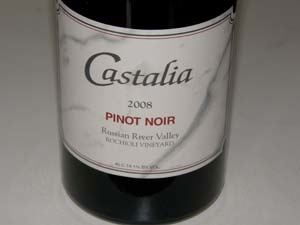 2008 Castalia Rochioli Vineyard Russian River Valley Pinot Noir 15.5% alc., pH 3.56, 354 cases, $50. 50% River Block and 50% Flad Vineyard. Warmer growing season. Unfiltered. · Moderately light reddish-purple color in the glass. Gorgeous nose of vivid black cherry and black raspberry perfume complimented by oak. Mature black cherry flavors flood the palate with interesting notes of cherry cola, oak spice, umami and red Jolly Rancher lingering on the amazing finish that seems to last an eternity. Definitely ripe flavored. Perfect oak integration and well matched tannins. Similar to the 2009 vintage. Irresistible.
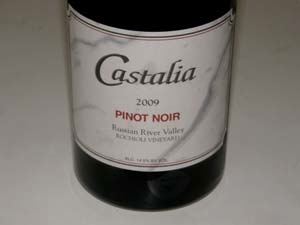 2009 Castalia Rochioli Vineyard Russian River Valley Pinot Noir 14.95% alc., pH 3.57, 352 cases, $55. 40% Dijon 115 and 667 for the first time. 50% River Block and 50% Flad Vineyard West Block clone. Perfect growing season with enough warm days to achieve optimum ripening. Aged 15 months in 30% new French oak barrels. · Medium reddish-purple robe. Quintessential Russian River Valley Pinot Noir with typical bright aromas of Bing cherries, red raspberries, dark red roses, and exotic spice. Delicious and polished on the palate with a generous endowment of cherries jubilee, ripe strawberry, raspberry and plum flavors wrapped in well-mannered tannins with a cherry cola and spice box finish that lingers, slipping off the back of the palate and leaving an overwhelming impression of luxury.
Pinot Briefs
 New Book on Pinot Noir Bestselling author Benjamin Lewin (Wine Myths and Reality and What Price Bordeaux?), a Master of Wine, has published In Search of Pinot Noir. Lewin travels from Burgundy through the other cool climates of Europe where Pinot Noir is grown, to the West Coast of North America, and to Australasia on the trail of the true Pinot Noir. The book investigates the changing character of Burgundy, asks what happens to Pinot Noir outside of Burgundy, and examines how the wines of each region age. The alternative styles of Pinot Noir are discussed and differences between Europe and the New World explored. The discussion of the regions of where Pinot Noir grows is accompanied by profiles of producers and tasting notes on current vintages from around the world. Illustrations are in four color with maps and photographs of every region. The book is distributed by the Wine Appreciation Guild and is available at bookstores and online. 480 pages, hardcover, $45. New Books on Natural Wine Natural wine is a hot topic in the wine world and several books have recently been published that address this controversial subject: Naked Wine: Letting Grapes Do What Comes Naturally (Alice Feiring), Voodoo Vintners: Oregon’s Astonishing Biodynamic Winegrowers (Katherine Cole), and Authentic Wine: Toward Natural and Sustainable Winemaking (Jamie Goode and Sam Harrop MW). The definition of natural wine has been subject to a number of interpretations. Wikipedia defines natural wine as follows: “Natural wine is wine made with as little chemical and technological intervention as possible, either in the way the grapes are grown or the way they are made into wine. Nothing is added or taken away from the grapes, must or wine.” Other definitions specify that the wine be made from a biodynamically or organically farmed vineyard using only indigenous yeasts and very little or even no added sulfites. Andrew Jeffords Blog Entry in Decanter Jeffords consults on the wine list at a major London restaurant. He said on 9/19/11, “We are resigned, as a footnote, to selling a little less Domaine de la Romanée Conti next year than last, since it seems unlikely that younger members of the Gaddafi family will be dining out in London much over the coming year - and they were devoted customers. If any of our clouds has a silver lining, that’s the one.” Davis Family Vineyards Releases 2007 Pinnacole The first reserve wine, Pinnacole, from Guy Davis’s own home estate vines was released from the 2006 vintage over a year ago. Crafted from three barrels, I thought this wine was exceptional. Earlier this month, the 2007 Pinnacole was released to mailing list customers. The wine receives additional barrel and bottle aging before release. Some of the wine may still be available from the winery ($60, minimum three bottle purchase). A small amount of the 2006 vintage Pinnacole may also be for sale. Contact Annie Rambo at annie@daviswines.com or call 866-338-9463.
 20th Anniversary of ¡Salud! Tickets are now on sale for this annual event in Oregon. Tasting and Big Board Auction is Friday, November 11, 2011 at Domaine Drouhin Oregon where the 2010 Oregon vintage of Pinot Noir will be debuted. Collectible ¡Salud! Cuvées will be offered from the following Vintner’s Circle wineries: Adelsheim Vineyard, Amalie Robert Estate, Antica Terra, ArborBrook Vineyards, Archery Summit, Argyle, Ayres Vineyard, Beaux Frères, Bethel Heights, Chehalem, Cristom Vineyards, Dobbes Family Estate, Domaine Drouhin Oregon, Dusky Goose, Elk Cove Vineyards, Erath Winery, Evening Land Vineyards, Hamacher Wines, Ken Wright Cellars, King Estate Winery, Lange Estate Winery, Maysara Winery, Patricia Green Cellars, Patton Valley Vineyard, Penner-Ash Wine Cellars, Ponzi Vineyards, R. Stuart & Co., Raptor Ridge Winery, Scott Paul Wines, Shea Wine Cellars, Silvian Ridge, Sokol Blosser, Soléna Estate, Soter Vineyards, St. Innocent Winery, Stoller Vineyards, Torii Mor, Willakenzie Estate, Willamette Valley Vineyards, Winderlea Vineyard & Winery, and Witness Tree Vineyard. The black tie optional Dinner & Auction Gala follows on Saturday, November 12, 2011 at The Governor Hotel in Portland. Tickets may be purchased online for one or both events: http://www.saludauction.org/auction/the-oregon-pinot-noir-auction/purchase-tickets/ or call 503-681-1850. ¡Salud! is the only health care program of its kind in the United States. In no other farming industry in this country, do workers receive regular and comprehensive on site, free medical assistance.
 Attica Terra Releases First Estate Wine When winemaker Maggie Harrison and her four partners acquired Attica Terra Vineyard in 2005, the vineyard was in need of much love. In the fall of 2005, the wine made that first year from the property was declassified. In the following vintages, fruit from Shea Vineyard was used to supplement the limited estate fruit. In 2008, five additional acres of vines were planted on a steep hillside. Three thousand tons of rock were removed to plant the new vineyard, six times more than what the owners were told was the worst-case scenario. The new vines struggled in the shallow mixture of soil and shattered rock but eventual success was achieved. In 2009, 164 cases of the first wine made exclusively from fruit grown at Antica Terra Estate Vineyard is being offered. In addition, an inaugural Chardonnay was produced. The wines are now available through a mailing list at www.anticaterra.com.
 Benovia Winery Harvests Solar Energy Like a number of wineries concerned about sustainability, Benovia Winery in Santa Rosa, California, has installed solar panels that will supply most of the electricity the winery needs. 171 photovoltaic modules were placed on the roof of the winery and are expected to produced 60,000 kilowatt hours of electricity annually, reducing the winery’s electric bill by at least 92 percent. The instillation will also reduce CO2 emissions by 1180 tons over 25 years, the environmental equivalent of more than 20 acres of planted trees. Some other initiatives Benovia Winery has undertaken in its ongoing sustainability program at the winery and its three estate vineyards include: farming the winery’s Cohn Vineyard organically, using organic mulch and fertilizer on all estate vineyards, erecting owl boxes and raptor roosts to encourage native predators, conserving water with dry farming techniques, controlling soil erosion with cover crops, straw mulching and drainage system maintenance, and using wind machines to replace water for frost protection.
 Hanzell Proud of New Website Hanzell has a very compelling story spanning over sixty years. Recently, archival photos and correspondence from the early 1950s was searched and the depth of the historical information became the inspiration for the creation of the new Hanzell website at www.hanzell.com. This has become one of the most comprehensive and informative wine websites on the internet. Hanzell Vineyards consist of 44 acres of Pinot Noir and Chardonnay planted high on the Mayacamas Range of mountains overlooking the town of Sonoma. The plantings include the 1953 Ambassador’s Vineyard, the oldest Pinot Noir vineyard and the oldest continuously producing Chardonnay vineyard in North America. The Hanzell Clone Pinot Noir and Hanzell Clone Chardonnay are important California heritage clones and the bud wood has been propagated to establish other vineyards throughout California and Oregon. A tour and tasting at this beautifully preserved historical site should be part of every pinotphile’s itinerary at some time during their travels. The wines are exceptional and age extremely well.
 Santa Cruz Mountains Commercial Wine Competition In this year’s competition consumer judges awarded Gold Medals to 41 wines and wine trade judges awarded 17 Gold Medals. The combined scores brought 15 Santa Cruz Mountains wineries the First Place Medal. The difference between male and female scores was not dramatic. The woman judges awarded Gold Medals to 47 wines with 7 of those above 95 points while the male judges chose 32 wines as Gold Medal quality. The Best Santa Cruz Mountains Red was awarded to the 2007 Byington Winery & Vineyard Estate Block 4 Pinot Noir. This year’s competition was between 158 wines from 34 local wineries and is the official competition for the Santa Cruz County Fair. There were some prominent Santa Cruz Mountains wineries that did not submit wines such as Rhys Vineyards, Thomas Fogarty, and Windy Oaks. The complete results are posted at www.scma.com. 2011 Sonoma County Harvest Fair Wine Competition This annual competition is always worth paying attention to as a large number (more than 1,000) of Sonoma County wines are submitted and sampled by 25 judges from throughout the United States and Asia. It is the largest regional wine competition in the United States. There are a number of prominent wineries that did not participate such as Williams Selyem, Rochioli Vineyards & Winery, Alysian and Papapietro Perry. One of three Sweepstakes Winners was the 2007 Gloria Ferrar Caves & Vineyards Carneros Brut Rose. Other results for Pinot Noir were as follows. Up to $24.99 category: Gold Medal for 2009 Rodney Strong Vineyards Russian River Valley Pinot Noir ($20) and 2009 Sebastiani Vineyards & Winery Sonoma Coast Pinot Noir ($18). $25 to $34.99 category: Double Gold Medal for 2010 Balletto Vineyards Russian River Valley Pinot Noir ($28). Gold Medal for 2008 Calstar Sonoma Coast Pinot Noir ($28.50), 2008 Macrae Family Winery Russian River Valley Pinot Noir ($30), 2009 Sandole Wines Russian River Valley Pinot Noir ($34), 2010 VML Russian River Valley Pinot Noir ($30), and 2010 Windsor Vineyards Sonoma County Pinot Noir ($30). $35 and over category: Best of Class for 2008 TR Elliott Burgonet Russian River Valley Pinot Noir ($40); Gold Medal for 2009 Armida Russian River Valley Pinot Noir ($39), 2009 Armida Sonoma Valley Pinot Noir ($45), 2009 Balletto Vineyards Russian River Valley Pinot Noir ($40), 2009 Davis Bynum Russian River Valley Pinot Noir ($35), 2009 DeLoach Vineyards OFS Russian River Valley Pinot Noir ($40), 2009 Gracianna Russian River Valley Pinot Noir ($48), 2009 Graton Ridge Celars Russian River Valley Pinot Noir ($50), 2009 Lost Canyon Winery Russian River Valley Pinot Noir ($45) and the 2009 Orsi-Papale Russian River Valley Pinot Noir ($35). The TR Elliott Pinot Noirs are not well known but they are consistently superb and frequent winners at the Sonoma County Harvest Fair. Visit www.trelliott.com. The three day Harvest Fair is held September 30-October 2 and includes the World Championship Grape Stomp and Grand Tasting where unlimited tastings of the award-winning wines are offered. Visit www.harvestfair.org. 3rd Annual Wood Fired Fall Festival Pizza from Rosso’s Pizza Oven paired with wines from four Old Roma Station wineries in Healdsburg including Hart’s Desire Wines, J Keverson Winery, Sapphire Hill Winery and Skewis Wines. Winemakers and winery owners will be available to discuss the wines and the 2011 harvest. The cluster of winery tasting rooms is located a couple blocks off the Healdsburg square at 53 Front St. Tickets are available at www.oldromastation.com. Sonoma County Tourism Board Free iPhone App This app enables you to plan your tasting room itinerary, make reservations at nearby restaurants and search hotels. You can also find spas, museums, events and even breweries within the county. Visit www.sonomacounty.com/content/iphone. J Vineyards & Winery 25th Anniversary Celebration A special public celebration and harvest party was held at J Vineyards & Winery on Saturday, September 17. As you can see from the photo below (with J Founder and President Judy Jordan and daughter Nicole), my wife and I attended, and enjoyed the day immensely.
 The special celebration featured oysters from Hog Island Oyster Company, Tsar Nicoulai Caviar, and interesting spiced popcorns from the Savory Spice Shop in Santa Rosa. The seven wine-food pairing stations are noted on the menu below. George Rose, Director of Public Relations for J was on hand and was showing his amazing wine country photographs in a new gallery located within the winery (visit www.georgerose.com). In 1991, J launched its first wine, a 1987 Vintage Brut. It was an instant success and J was embraced as the “essence of style” as an all-American alternative to French Champagne. The winery still produces excellent sparkling wine, but the focus is now on Pinot Noir from grapes farmed within Sonoma County’s Russian River Valley and Sonoma Coast appellations. J’s newest winemaker is Melissa Stackhouse (formerly La Crema) who will put the finishing touches on the 2010 vintage. I was very impressed by the 2009 Robert Thomas Vineyard Block 2 Russian River Valley Pinot Noir, the 2009 Russian River Valley Pinot Noir and the 2010 16 Barrel Pinot Noir offered from barrel. If you haven’t tried J Pinot Noir, you are missing out. Also, the pairing of 2004 J Vintage Brut Magnum with assorted caviar hors d’oeuvres was to die for.
 Ram’s Gate Winery Opens in Sonoma Carneros On September 19, 2011, the new Ram’s Gate Winery opened for business. Located at the old Roche Winery site, the architect for the 22,000-squarefoot, 30-acre project was Howard Backen, who has done Screaming Eagle, Meadwood Resort and more. The executive chef will be Jason Rose, formerly the project manager at Delfina Restaurant Group and before that, culinary directory for The Tyler Florence Group. Rose will be developing small plate pairings for wine tastings to be held in the winery’s underground cellar next to the barrel room. There will also be an open kitchen for chef demonstrations, picnic foods and private wine dinners. The winemaker is veteran Jeff Gaffner, previously of Saxon Brown, Xtant, Stephanie and Black Kite Cellars. Only a 40 minute drive north of San Francisco, this is certain to be a popular destination winery in Sonoma. Redtree Very Successful You probably have seen Redtree Pinot Noir in your local supermarket. It is a decent reasonably priced wine in the $10 range. Launched in 2007 by industry veteran Roy Cecchetti, Sonoma’s Cecchetti Wine Co., Redtree, a California-appellation brand, saw its volume rise 24.5% to 137,000 cases last year. Redtree is projected to be at over 150,000 cases by the end of this year. Their success is based on providing wholesalers a volume brand and profitability, building a foothold in chain-dominated California. For reviews of the last two vintages, visit www.princeofpinot.com/winery/912/.
 Comic Book Writers Are Top Asian Wine Critics An article recently published at gilttaste.com caught my attention. A brother and sister duo, Shin and Yuko Kibayashi are the writers for the Japanese manga comic, The Drops of Gold. The comic features both good and bad wine-drinking characters and instructs readers on tasting wine in an unpretentious and comical way. The comic series has sold millions of copies worldwide and has been translated to Taiwanese, Korean and French. Soon the series will be available in English from New York Japanese-owned publisher Vertical Inc. The Kibayashis increased wine sales in Japan by 130 percent their first year of publication. Their mere mention of a wine can lead to a marked increase in the wine’s price tag in Japan. Visit www.vertical-inc.com. Alexana To Open New Tasting Room Alexana was launched in 2005 by Dr. Madaiah Revana, owner of the renowned Napa Valley winery of the same name, and the first two wines, a Pinot Noir and Pinot Gris, were released the following year. The 80-acre Revana Vineyard is located in the Dundee Hills. Lynn Penner-Ash crafts the wines at her own winery. The wines have been available for tasting in Carlton but a new architecturally pleasing tasting room will open at 12001 Northeast Worden Hill Rd in Dundee in October 2011. Visit www.alexanawinery.com or follow on Twitter at twitter.com/Alexana Winery. Oregon Wine License Plate On August 5, 2011, Oregon Governor John Kitzhaber signed into law a bill that permits Oregon to offer a wine specialty license plate to registered motorists in Oregon. The new plates show a vineyard with the words, “Oregon Wine Country.” California, are you listening?
 Amy Wesselman New Executive Director of IPNC Wesselman, who, with her spouse, owns Westrey Wines in McMinnville, has returned to take over directorship of the IPNC following the departure of Whitney Schubert who left to take a position as Brand Manager for wine importer Polaner Selections in New York. Wesselman previously was the Executive Director of IPNC from 1998 to 2008. Article: Varietal Focus: How To Make Great Pinot Noir In the September issue of Wine Business Monthly, there is a very informative article written by Lance Cutler. Three winemakers from each of four distinctively different Pinot Noir producing regions (Anderson Valley, Willamette Valley, Sonoma County, and Santa Barbara County) stated their Pinot Noir winemaking goals and gave detailed accounts of their viticultural, fermentation and aging practices. 12 wines were present and discussed by winemakers with detailed comments. The featured winemakers included Jason Drew (Drew Family Cellars), Jim Klein (Navarro), Doug Stewart and Ryan Hodgins (Breggo), Harry Peterson-Nedry (Chehalem), Dick Shea (Shea Wine Cellars), Ken Wright (Ken Wright Cellars), Ted Lemon (Littrorai), Ross Cobb (Cobb Wines), Eva Dehlinger (Dehlinger), Jim Clendenen (Au Bon Climat), Justin Willett (Tyler), and Adam Tolmach (The Ojai Vineyard). Pinotphiles will love the details in this article. If you are not a subscriber of the print magazine, look for this article on the magazine’s website at www.winebusinessmonthly in October. Sixth International Wine & Heart Health Summit, Newberg, Oregon Even if you cannot attend this three day presentation of research on wine and heart health, you may go to the Saturday night Wine Dinner and Benefit Auction, “An Affair of the Heart.” Information below.

|